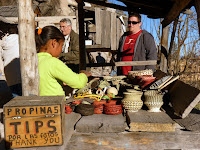One of the joys of Mexican electricity is the opportunity to meet it up close and personal.
I am not talking about the usual Gordian knot of power lines seen on many Mexican electrical poles -- even though they would make an interesting post.
What I am talking about is the almost universal lack of grounding in Mexican electrical systems. Now, I know that sentence is not scientifically accurate. After all, electrical current is always grounded at one point. And that point, in an Mexican home, is likely to be you.
It certainly has been me recently.
I have a computer station in my living room where all of my computer gear is hooked up to one extension cord that runs through both a surge protector, and a combined voltage regulator and battery backup.
It looks quite impressive. Maybe a bit too many bare cords for the feminine eye. But it appeals to my testosterone-driven sense of technology
But like most apparently impressive systems, it is an illusion. Because the electrical system to my house has no built-in grounding, touching any metal part on my computer table will give me a bigger jolt than Newt Gingrich endorsing Barak Obama.
And I have discovered the same problem with my new notebook computer. Having taken to my sick bed, I brought it along for a bit of diversion. A few moments ago, I stood up while holding it. A radio falling into a bath tub could not have given me a larger jolt.
Well, I suppose it could have. But the distinction was academic while it was happening. Apparently, my bed was not a very good electrical conductor. But the moment my foot hit the tile floor, resistance was no longer futile.
The problem is hardly exclusive to Mexico. I remember when I was growing up, there was at least one table or floor lamp that offered a shocking experience when turning it off and on.
But I am certain that the random electricity running through my computer systems cannot be good for them. And my constant nomination to be the next Reddy Kilowatt is probably doing nothing for me, either.
There are some things about Mexico I am happy to keep impersonal.


















































